Mechanisms of Heavy Rainfall over the Southern Anhui Mountains: Assessment for Disaster Risk
Abstract
1. Introduction
2. Materials and Methods
2.1. Study Area and Regional Heavy Rainfall Events
2.2. Data
2.3. Hybrid Single-Particle Lagrangian Integrated Trajectory Model
2.3.1. Trajectory Tracing and Clustering Analysis
2.3.2. Schemes of Water Vapor Trajectory Tracking and Clustering Analysis
2.4. Rainstorm Disaster Risk Assessment Method
- Information entropy weighting method
- 2.
- Principal component analysis
- 3.
- Multiple linear regression fitting power exponent
3. Results
3.1. Temporal and Spatial Distribution of Precipitation
3.2. Transport Trajectories and Sources of Water Vapor
3.3. Analysis of Circulation Situation
3.3.1. Weather Situation and Water Vapor Condition
3.3.2. Relationship Between Circulation Indices and Rainstorm Events in the Southern Anhui Mountains
3.4. Disaster Risk Assessment
4. Discussion
5. Conclusions
- The atmospheric circulation systems such as the WPSH, EASM, and SAH play a decisive role in regulating water vapor transport, convergence, and spatiotemporal variability of precipitation in the southern Anhui region. Especially with the westward extension and northward jump of WPSH, a channel for continuous invasion of warm and humid air currents has been formed. Combined with the synergistic effect of the westerly belt and monsoon system, it enhances the dynamic uplift, which is conducive to the occurrence of extreme precipitation.
- The reverse trajectory and cluster analysis using the HYSPLIT model indicate that the main sources of extreme rainfall are Southeast Asia, the South China Sea, the Western Pacific, and inland regions of China, with multi-level and multi-channel transport. The terrain uplift in mountainous areas further improves precipitation efficiency, leading to significant spatial heterogeneity and local precipitation extremes.
- The rainstorm disaster risk assessment based on principal component analysis, the entropy weight method, and multiple regression shows that the number of heavy rainfall stations and short-term extreme precipitation are important predictors of disaster risk, and the multiple linear regression fitting power index is the best for the assessment and classification of disaster-causing rainstorm events.
Author Contributions
Funding
Data Availability Statement
Acknowledgments
Conflicts of Interest
References
- Li, X.; Du, Y. Statistical relationships between two types of heavy rainfall and low-level jets in South China. J. Clim. 2021, 34, 8549–8566. [Google Scholar] [CrossRef]
- Ou, Q.; Zhao, T.; Wang, S.; Liu, Y.; Wu, Y.Y.; Li, B.; Chen, X.H. Relating extreme precipitation events to atmospheric conditions and driving variables in China. Clim. Dyn. 2024, 62, 4925–4942. [Google Scholar] [CrossRef]
- Liu, W.H.; Wu, J.D.; Tang, R.M.; Ye, M.Q.; Yang, J. Daily precipitation threshold for rainstorm and flood disaster in the mainland of China: An economic loss perspective. Sustainability 2020, 12, 407. [Google Scholar] [CrossRef]
- Wang, B.; Liu, J.; Liu, G.; Gao, P.; Anwar, S.; Wu, Z.; Li, M.; Li, D. Spatiotemporal analysis and threshold modeling of rainfall-induced geological disasters in Anhui Province. Front. Earth Sci. 2025, 13, 1541242. [Google Scholar] [CrossRef]
- Guo, H.; Hu, W.; Yang, C.; Wan, F. Moisture sources and atmospheric circulation patterns for extreme rainfall event over North China Plain from 29 July to 2 August 2023. Earth Space Sci. 2024, 11, e2024EA003956. [Google Scholar] [CrossRef]
- Ding, Y.; Liu, Y.; Hu, Z.Z. The record-breaking Mei-yu in 2020 and associated atmospheric circulation and tropical SST anomalies. Adv. Atmos. Sci. 2021, 38, 1980–1993. [Google Scholar] [CrossRef]
- Chen, W.; Zhang, R.; Wu, R.; Wen, Z.; Zhou, L.; Wang, L.; Hu, P.; Ma, T.J.; Piao, J.L.; Song, L.; et al. Recent advances in understanding multi-scale climate variability of the Asian monsoon. Adv. Atmos. Sci. 2023, 40, 1429–1456. [Google Scholar] [CrossRef]
- Luo, Y.; Sun, J.; Li, Y.; Xia, R.; Du, Y.; Yang, S.; Zhang, Y.C.; Chen, J.; Dai, K.; Shen, X.S.; et al. Science and prediction of heavy rainfall over China: Research progress since the reform and opening-up of new China. J. Meteor. Res. 2020, 34, 427–459. [Google Scholar] [CrossRef]
- Wei, W.; Zhang, R.; Wen, M.; Kim, B.J.; Nam, J.C. Interannual variation of the South Asian high and its relation with Indian and East Asian summer monsoon rainfall. J. Clim. 2015, 28, 2623–2634. [Google Scholar] [CrossRef]
- Shang, K.; Liu, X.D.; Xie, X.N.; Sha, Y.Y.; Zhao, X.; Liu, J.H.M.; Wang, A.Q. Synergistic Impact of Midlatitude Westerly and East Asian Summer Monsoon on Mid-Summer Precipitation in North China. Atmosphere 2025, 16, 658. [Google Scholar] [CrossRef]
- Zhao, W.; Ma, Y.; Takemi, T.; Chen, X.; Cao, D. Investigating the underlying mechanisms of monsoon season heavy precipitation in central Asian high mountain areas. J. Clim. 2025, 38, 277–292. [Google Scholar] [CrossRef]
- Wang, G.; Hu, Z.; Yu, H.; Sun, G.; Fan, W.; Niu, R.; Zhang, B. Tibetan Plateau Vortex Activity and Its Relationship With the Tibetan Plateau Summer Monsoon and Precipitation. Int. J. Climatol. 2025, 45, e8713. [Google Scholar] [CrossRef]
- Hua, W.; Fan, G.; Wang, B. Variation of Tibetan Plateau Summer Monsoon and Its Effect on Precipitation in East China. Chin. J. Atmos. Sci. 2012, 36, 784–794. [Google Scholar]
- Zhang, Q.Y.; Tao, S.Y.; Chen, L.T. The interannual variability of East Asian summer monsoon indices and its association with the pattern of general circulation over East Asia. Acta Meteorol. Sin. 2003, 61, 559–569. [Google Scholar]
- Zhao, Y.; Cheng, J.; Feng, G.; Zhi, R.; Zheng, Z.; Zhang, Z. Analysis of the atmospheric direct dynamic source for the westerly extended WPSH and record-breaking Plum Rain in 2020. Clim. Dyn. 2022, 59, 1233–1251. [Google Scholar] [CrossRef]
- Li, X.; Zhou, W.; Chen, Y.D. Detecting the origins of moisture over southeast China: Seasonal variation and heavy rainfall. Adv. Atmos. Sci. 2016, 33, 319–329. [Google Scholar] [CrossRef]
- Yu, J.; Li, Q.; Ding, Y.; Ding, Y.; Wen, Z.; Gong, Z.; Sun, X.; Shen, X.; Dong, L. AMO modulation of interdecadal background of persistent heavy rainfall in summer over the Huaihe River Basin. Clim. Dyn. 2024, 62, 3621–3640. [Google Scholar] [CrossRef]
- Jiang, Z.; Ren, W.; Liu, Z.; Yang, H. Analysis of water vapor transport characteristics during the Meiyu over the Yangtze-Huaihe River valley using the Lagrangian method. Acta Meteorol. Sin. 2013, 71, 295–304. [Google Scholar]
- Yang, H.; Jiang, Z.; Liu, Z.; Zhang, Q. Analysis of climatic characteristies of water vapor transport based on the Lagrangian method: A comparison between Meiyu in the Yangtze-Huaihe River region and the Huaibei rainy season. Chin. J. Atmos. Sci. 2014, 38, 965–973. [Google Scholar]
- Sha, X.; Ding, J.; Chu, R.; Ma, X.; Li, X.; Xiao, Y.; Cheng, B.; Zhang, F.; Song, C.; Wang, S. Characteristics of Water Vapor Transport during the “7·20” Extraordinary Heavy Rain Process in Zhengzhou City Simulated by the HYSPLIT Model. Water 2024, 16, 2607. [Google Scholar] [CrossRef]
- Huang, S.; Xuan, W.; Qiu, H.; Ye, J.; Chen, X.; Nie, H.; Chen, H. Assessing Flood Risks in Coastal Plain Cities of Zhejiang Province, Southeastern China. Water 2024, 16, 3208. [Google Scholar] [CrossRef]
- Guo, P.; Yuan, Y.; Peng, Y.; Zhang, H.; Zhao, Y. Analysis of slope stability and disaster law under heavy rainfall. Geofluids 2021, 2021, 5520686. [Google Scholar] [CrossRef]
- Xiao, T.; Wang, Y.; Zhao, Y.; Jing, F.; Fang, Y. The hazard risk assessment of regional heavy rainfall over Sichuan Basin of China. Nat. Hazards 2017, 88, 1155–1168. [Google Scholar] [CrossRef]
- Liu, H.; Zhang, D.L. Analysis and prediction of hazard risks caused by tropical cyclones in Southern China with fuzzy mathematical and grey models. Appl. Math. Model. 2012, 36, 626–637. [Google Scholar] [CrossRef]
- Li, H.M.; An, J.J.; Qiu, X.X.; Zheng, L.L.; Liu, J.; Li, J.; Wu, R.J.; Zhou, X.Y. Characteristics of convective storm activity during the warm season over Anhui Province based on radar mosaic climatology and the possible causes. Torrential Rain Disasters 2023, 42, 554–562. [Google Scholar]
- Tong, J.; Wei, L.X.; Zhang, J.; Wang, D.Y. Statistical analysis of climatological characteristics of spring rainstorm in Anhui province. Torrential Rain Disasters 2016, 35, 504–510. [Google Scholar]
- Ren, M.; Chen, Y.; Qu, Y. Relationship between Rainstorm Areas and Some Physical Variables. Meteor Mon 2006, 32, 40–44. [Google Scholar]
- DB34/T 4271-2022; Classification of Regional Rainstorm Process. Anhui Provincial Administration for Market Regulation: Anhui, China, 2022.
- Zhao, L.; Wei, T.X.; Wang, L.R.; Zhang, A. Objective Identification and Characteristics Analysis of Regional Rainstorm Processes Based on a Comprehensive Intensity Index and Affected Areas. Clim. Environ. Res. 2024, 29, 430–442. (In Chinese) [Google Scholar]
- Loughner, C.P.; Fasoli, B.; Stein, A.F.; Lin, J.C. Incorporating Features from the Stochastic Time-Inverted Lagrangian Transport (STILT) Model into the Hybrid Single-Particle Lagrangian Integrated Trajectory (HYSPLIT) Model: A Unified Dispersion Model for Time-Forward and Time-Reversed Applications. J. Appl. Meteorol. Climatol. 2021, 6, 799–810. [Google Scholar] [CrossRef]
- Stein, A.F.; Draxler, R.R.; Rolph, G.D.; Stunder, B.J.B.; Cohen, M.D.; Ngan, F. NOAA’s HYSPLIT Atmospheric Transport and Dispersion Modeling System. Bull. Am. Meteorol. Soc. 2015, 96, 2059–2077. [Google Scholar] [CrossRef]
- Salman, A.D.; Al-Jumaily, K.J.; AL-Salihi, A.M. Aerosol-cloud-precipitation interactions over Iraq using MODIS satellite data and HYSPLIT model during (2008–2017). AIP Conf. Proc. 2020, 2290, 050005. [Google Scholar]
- Li, Y.; Tan, G.; He, X.; Zeng, N. Analyse of the characteristics of moisture transport in Luzhou extraordinary rainstorm based on HYSPLIT Model. Plateau Mt. Meteorol. Res. 2020, 40, 49–52. [Google Scholar]
- Tan, J.; Zhao, H.; Yang, R.; Liu, H.; Li, S.; Liu, J. An entropy-weighting method for efficient power-line feature evaluation and extraction from lidar point clouds. Remote Sens. 2021, 13, 3446. [Google Scholar] [CrossRef]
- Bucherie, A.; Hultquist, C.; Adamo, S.; Neely, C.; Ayala, F.; Bazo, J.; Kruczkiewicz, A. A comparison of social vulnerability indices specific to flooding in Ecuador: Principal component analysis (PCA) and expert knowledge. Int. J. Disaster Risk Reduct. 2022, 73, 102897. [Google Scholar] [CrossRef]
- Sulca, J.; Takahashi, K.; Espinoza, J.C.; Tacza, J.; Zubieta, R.; Mosquera, K.; Apaestegui, J. A multiple linear regression model for the prediction of summer rainfall in the northwestern Peruvian Amazon using large-scale indices. Clim. Dyn. 2024, 62, 4431–4451. [Google Scholar] [CrossRef]
- Feng, W.; Fan, G.Z.; Long, Y.Y. The influence of tropical ocean on the South Asia High and the Western Pacifica Subtropical High. Adv. Clim. Change Res. 2018, 14, 111–119. [Google Scholar]
- Hu, J.; Zhou, B.; Tao, L. Comparative Analysis of the Relation Between Characteristic Parameters of South Asia High and Summer Precipitation of China. Meteor Mon 2010, 36, 51–56. [Google Scholar]
- Tang, M.C. Some study process in plateau monsoon. Plateau Meteor 1993, 12, 95–101. (In Chinese) [Google Scholar]
- Yan, H.; Hu, J.; Fan, K.; Zhang, Y. The Analysis of Relationship between the Variation of Westerly Index in Summer and Precipitation during the Flood Period over China in the Last 50 Years. Chin. J. Atmos. Sci. 2007, 31, 717–726. [Google Scholar]
- Wei, Y.; Yu, H. The interdecadal weakening of the relationship between Indian Ocean sea surface temperature and summer precipitation in Central Asia. Geophys. Res. Lett. 2024, 51, e2023GL107371. [Google Scholar] [CrossRef]
- Zhang, P.; Duan, A.; Hu, J. Combined effect of the tropical Indian Ocean and tropical North Atlantic sea surface temperature anomaly on the Tibetan Plateau precipitation anomaly in late summer. J. Clim. 2022, 35, 7499–7518. [Google Scholar] [CrossRef]
- Sun, B.; Wang, H.; Zhou, B.; Li, H.; Zhu, B. A review on the interannual and interdecadal variations of water vapor transport over China during past decades. Adv. Water Sci. 2020, 31, 644–653. [Google Scholar]
- Cheng, Z.; Gao, H.; Cao, Y. Decadal enhancement of connection between Somalia cross-equatorial flow and summer precipitation in Huaihe River basin. Chin. J. Atmos. Sci. 2018, 42, 1363–1377. [Google Scholar]
- Liu, Y.T.; Xu, G.L.; Yang, Z.; Reng, X.Z.; Yang, X.C.; Li, A.J. Variation of Extreme Temperature and Its Association with Climate Indices in Anhui Province During the Past 56 Years. Res. Soil Water Conserv. 2021, 28, 245–255. [Google Scholar]
- Lou, D.J.; Wang, Y.G.; Chen, C. Circulation Characteristics and Precursory Signals of Abnormal Meiyu Rainfall in the Middle and Lower Reaches of the Yangtze River in the Past 20 Years. Meteor Mon 2022, 48, 1130–1139. [Google Scholar]
- Zeng, T.; Yang, D.; Guo, P.P.; Song, M.; Ma, L.; Xue, S.Y. Characteristics of Precipitation and Temperature Variation and Their Correlation with ENSO in Anhui Province during 1960–2012. Trop. Geogr. 2014, 34, 783–793. [Google Scholar]
- Wang, Y.X. Research on the Impact Mechanism of Indian Ocean Dipole on Summer Extreme Precipitation in the Middle and Lower Reaches of the Yangtze River Based on the 2020 “Violent Plum Blossom”. Master’s Thesis, Lanzhou University, Lanzhou, China, 2024. [Google Scholar]
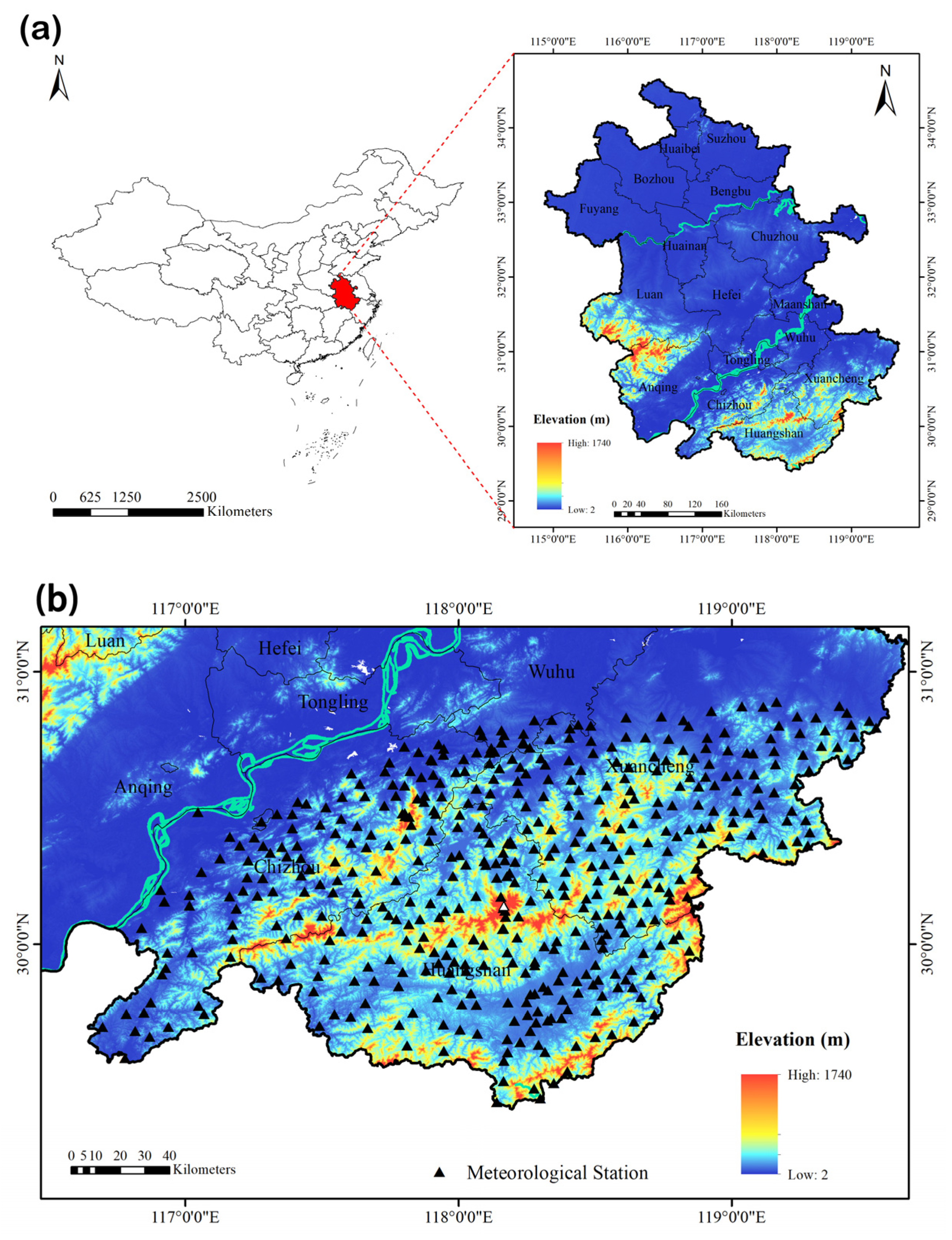
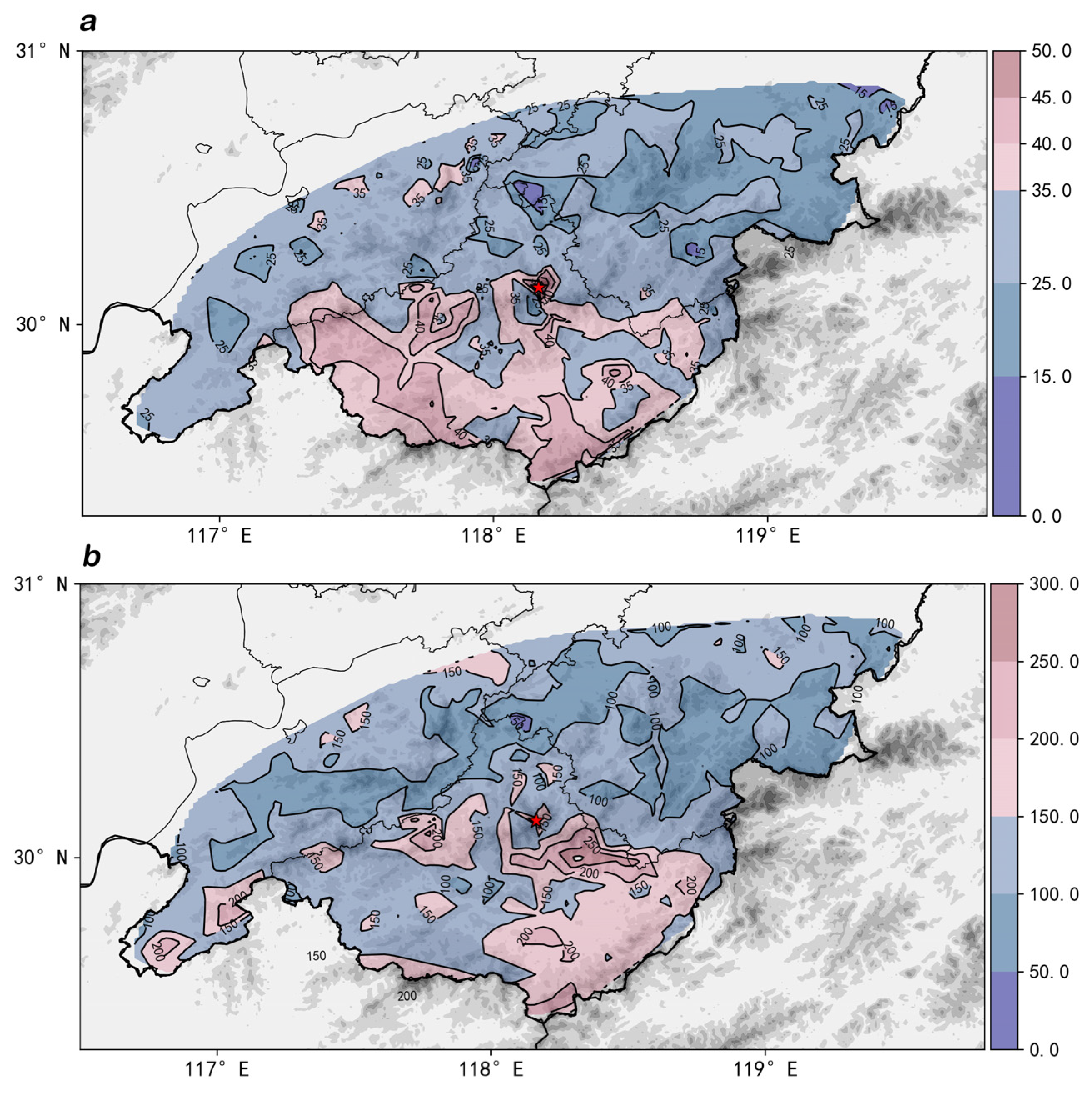

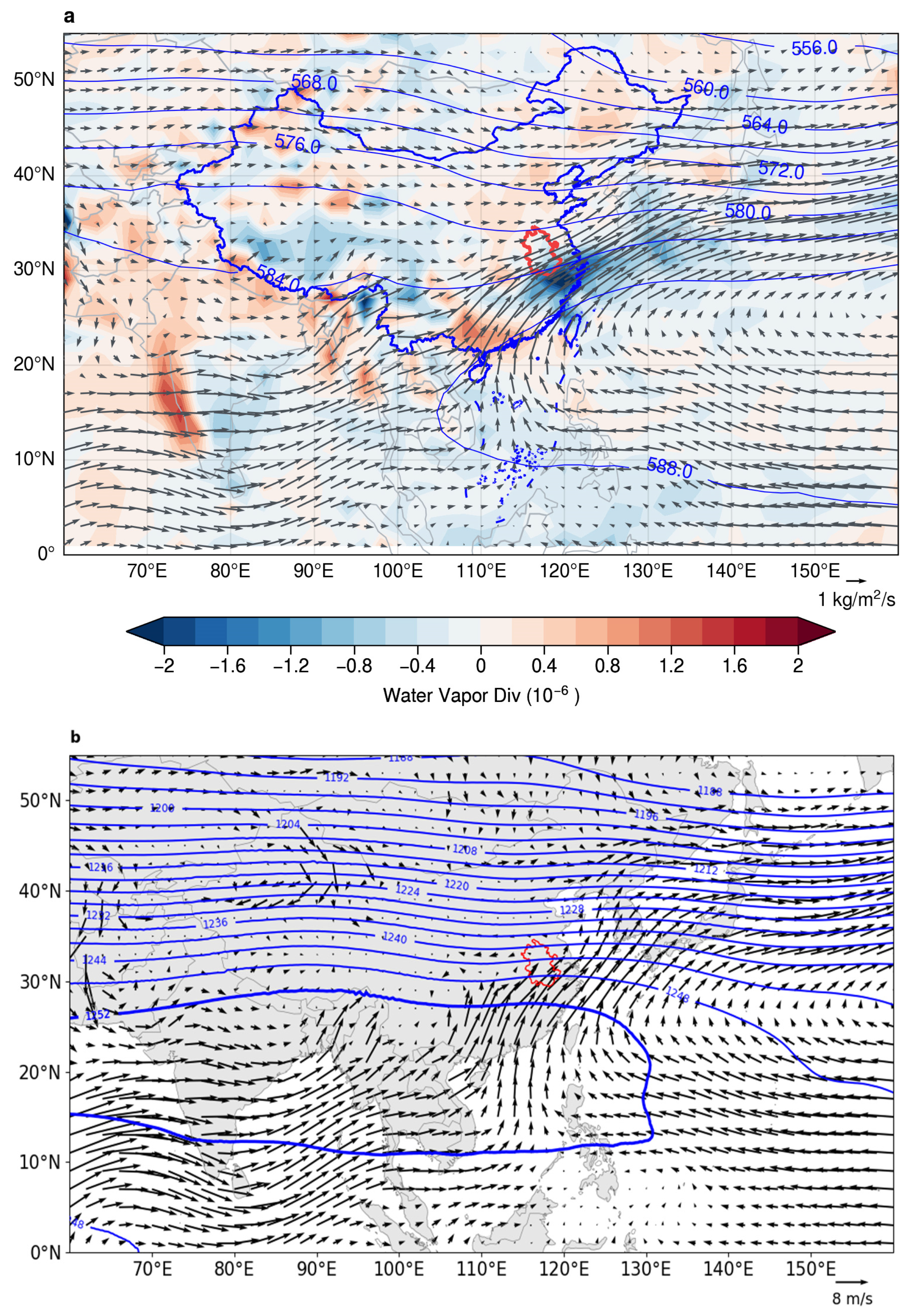
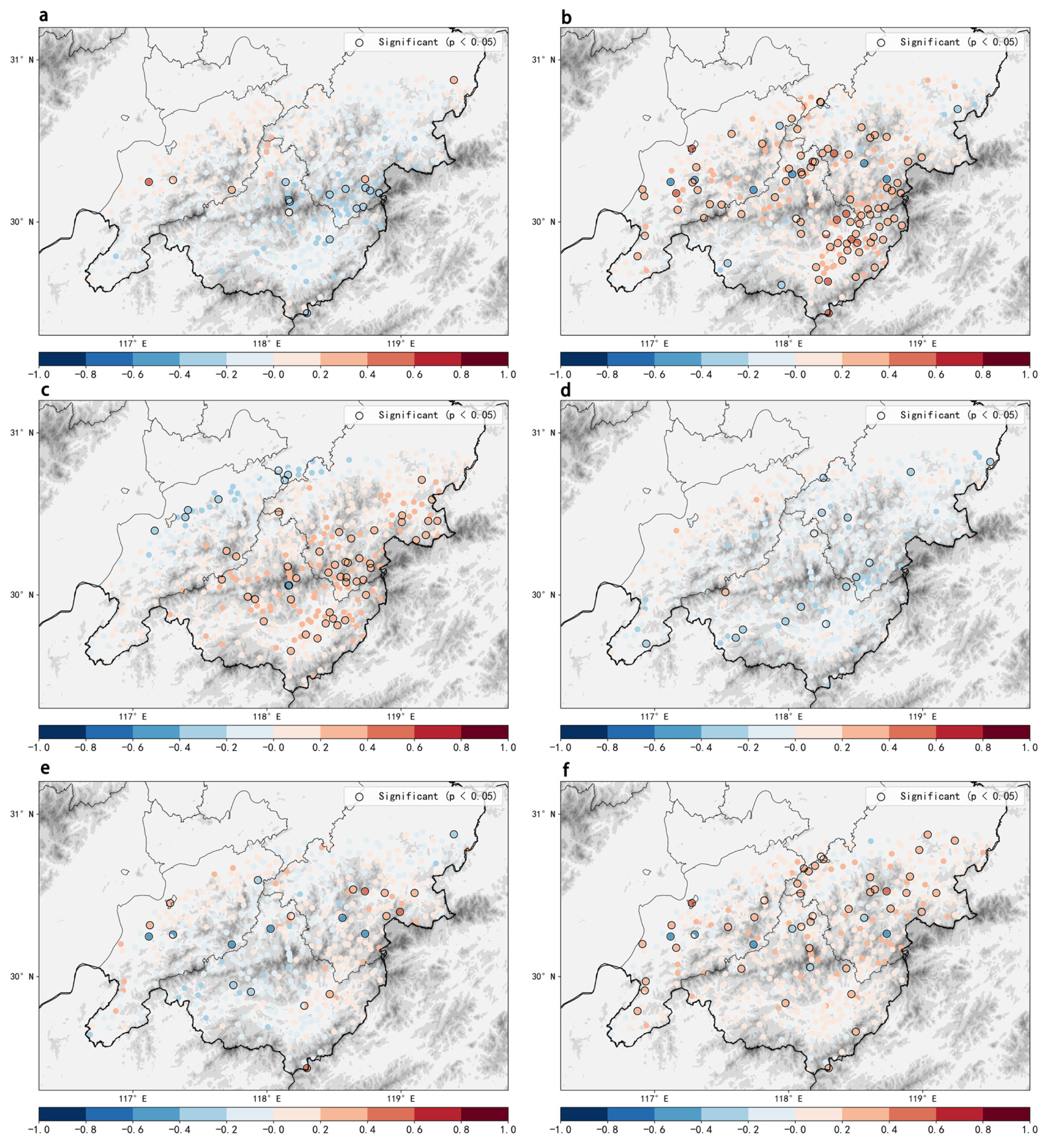

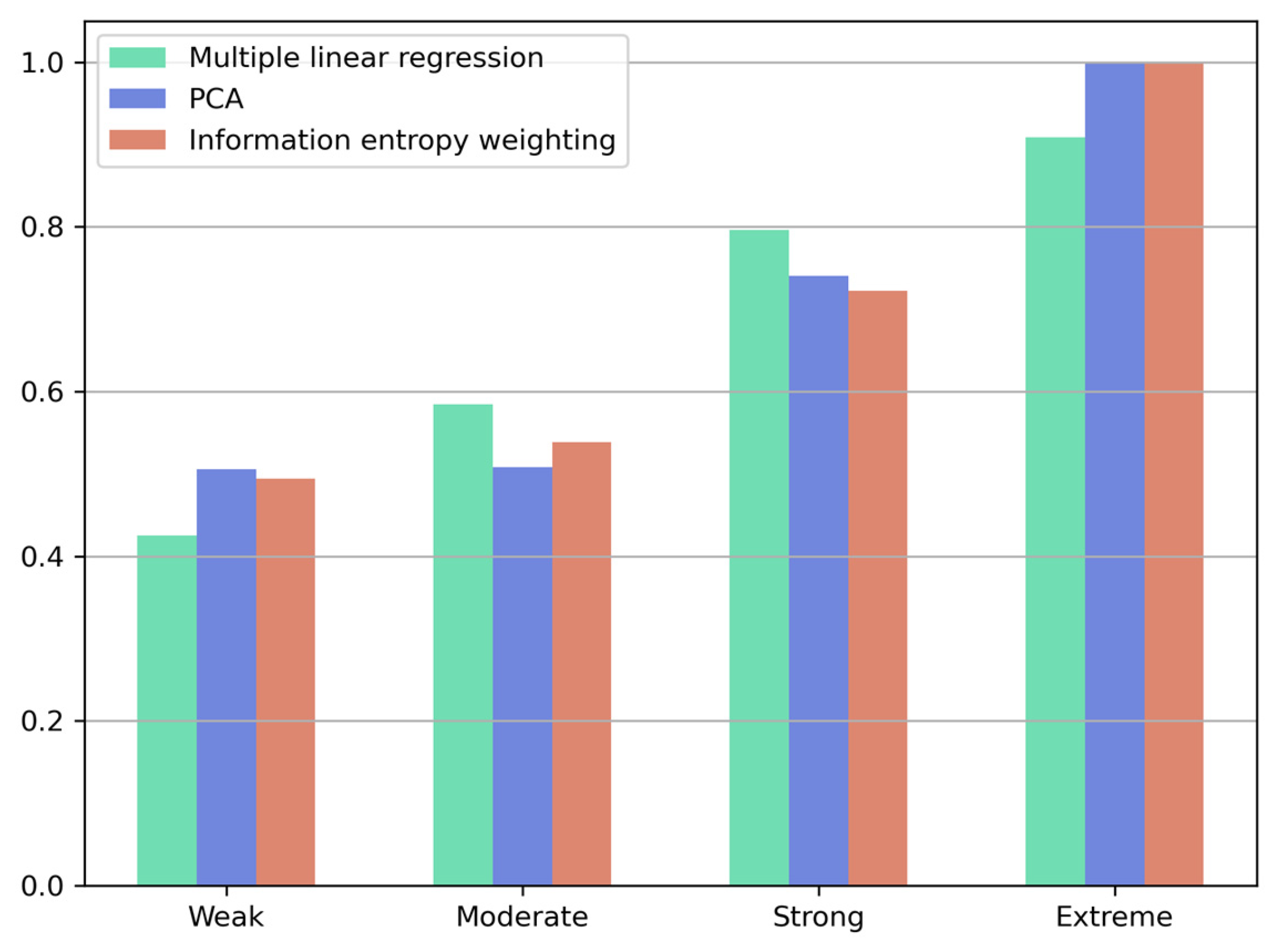
| Year | April | May | June | July | August | September | ||||||
|---|---|---|---|---|---|---|---|---|---|---|---|---|
| Disaster Event | No Disaster Event | Disaster Event | No Disaster Event | Disaster Event | No Disaster Event | Disaster Event | No Disaster Event | Disaster Event | No Disaster Event | Disaster Event | No Disaster Event | |
| 2022 | 0 | 3 | 1 | 0 | 3 | 3 | 0 | 0 | 0 | 0 | 0 | 0 |
| 2023 | 0 | 2 | 1 | 5 | 4 | 0 | 0 | 4 | 0 | 1 | 1 | 1 |
| 2024 | 0 | 3 | 0 | 3 | 11 | 1 | 0 | 3 | 0 | 3 | 0 | 1 |
| Total | 0 | 8 | 2 | 8 | 18 | 4 | 0 | 7 | 0 | 4 | 1 | 2 |
| Level | Southeast Asia | South China Sea | Inland Areas of Northwest China | Inland Areas of East China |
|---|---|---|---|---|
| 500 hPa | 70% | 13% | 17% | 0 |
| 700 hPa | 32% | 34% | 8% | 26% |
| 850 hPa | 0 | 59% | 13% | 26% |
| Total contribution | 102% | 106% | 38% | 52% |
| Strength Grade | Percentile of Intensity Index |
|---|---|
| Extra strong | >95% |
| Strong | (70%, 95%] |
| Moderate | (40%, 70%] |
| Weak | ≤40% |
Disclaimer/Publisher’s Note: The statements, opinions and data contained in all publications are solely those of the individual author(s) and contributor(s) and not of MDPI and/or the editor(s). MDPI and/or the editor(s) disclaim responsibility for any injury to people or property resulting from any ideas, methods, instructions or products referred to in the content. |
© 2025 by the authors. Licensee MDPI, Basel, Switzerland. This article is an open access article distributed under the terms and conditions of the Creative Commons Attribution (CC BY) license (https://creativecommons.org/licenses/by/4.0/).
Share and Cite
Sun, M.; Zhu, H.; Wang, D.; Ma, Y.; Zhao, W. Mechanisms of Heavy Rainfall over the Southern Anhui Mountains: Assessment for Disaster Risk. Water 2025, 17, 2906. https://doi.org/10.3390/w17192906
Sun M, Zhu H, Wang D, Ma Y, Zhao W. Mechanisms of Heavy Rainfall over the Southern Anhui Mountains: Assessment for Disaster Risk. Water. 2025; 17(19):2906. https://doi.org/10.3390/w17192906
Chicago/Turabian StyleSun, Mingxin, Hongfang Zhu, Dongyong Wang, Yaoming Ma, and Wenqing Zhao. 2025. "Mechanisms of Heavy Rainfall over the Southern Anhui Mountains: Assessment for Disaster Risk" Water 17, no. 19: 2906. https://doi.org/10.3390/w17192906
APA StyleSun, M., Zhu, H., Wang, D., Ma, Y., & Zhao, W. (2025). Mechanisms of Heavy Rainfall over the Southern Anhui Mountains: Assessment for Disaster Risk. Water, 17(19), 2906. https://doi.org/10.3390/w17192906







